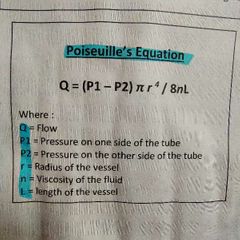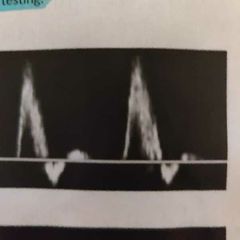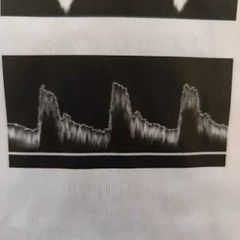![]()
![]()
![]()
Use LEFT and RIGHT arrow keys to navigate between flashcards;
Use UP and DOWN arrow keys to flip the card;
H to show hint;
A reads text to speech;
53 Cards in this Set
- Front
- Back
|
Where is the greatest pressure |
The heart |
|
|
What determines how much blood leaves the heart? ***@ |
Arterial pressure and peripheral resistance |
|
|
Venous return equals . . . |
Cardiac output |
|
|
What causes blood to move through the circulatory system? *** Amount of bloodflow depends on. . . |
Movement of any fluid requires a pathway and pressure/energy differential Amount depends on energy difference and resistance |
|
|
At what pressure does blood leave the heart? $$@ |
85-95mmHg this is a mean average |
|
|
Where does pressure begin to fall after leaving the heart? $$$@ |
Pressure falls very little though distributing arteries, Falls greatly at small arteries and arterioles, which are resistance vessels, falls to 25-30mmHg |
|
|
Flow refers to |
Volume per time |
|
|
Velocity refers to |
How fast is the blood moving, distance/time |
|
|
Steady flow is |
Constant flow |
|
|
Pulsatile velocities are due to *** |
Cardiac contractions |
|
|
Phasic flow is due to $$$ |
Respiration |
|
|
The total energy contained in moving fluid is the sum of? *** |
Potential (pressure) energy Kinetic (motion) energy Gravitational(hydrostatic pressure) energy |
|
|
3 forms of energy loss $$$ |
Friction - converted to heat Viscosity - the thicker the greater friction, anemia vs elevated hematocrit Inertia and momentum - object in motion well stay in motion and objects at rest will stay in rest unless acted on by external forces or constraints such as pulsatile flow, velocity, or directional changes. Ex at stenosis |
|
|
What increases viscosity? |
Elevated hematocrit |
|
|
Types of laminar flow $$$ |
Plug flow Parabolic flow |
|
|
What is the boundary layer |
Flow along vessel wall going slower than center |
|
|
Parabolic flow $$$@ |
Flow faster in the middle |
|
|
Eddy currents are common at |
Bifurcations |
|
|
Turbulent vs disturbed flow. Which is associated with disease? $$$@ |
Turbulent flow |
|
|
Reynolds number$$$@ |
A unitless number Predicts when stable fluid will become disturbed/turbulent flow Laminar flow <1500 Disturbed flow >2000 |
|
|
Resistance is ________ proportional to viscosity and length |
Directly Resistance increases with increasing viscosity and length |
|
|
Resistance is _________ proportional to vessel radius |
Indirectly Resistance increases as vessel radius decrease |
|
|
Poiseuille's Law $$$@ |
Flow(Q) = pressure(P) / resistance(R) Describes the relationship between pressure, flow, and resistance to flow |
|
|
Poiseuille's Equation $$$ |

|
|
|
What happens during early systole? |
Cardiac contraction Aortic valve opens High velocity ejection of blood |
|
|
What happens during late systole/ early diastole? What is dicrotic notch?*** |
Rapid deceleration and aortic valve closes Dicrotic notch represents aortic valve closure- results in temporary flow reversal
|
|
|
What happens in late diastole?*** |
Low velocity or no forward flow Depends upon the resistance of vascular bed
|
|
|
What is a major factor that dictates flow through the system? *** |
Peripheral vascular resistance of the vascular beds, arterioles/venules |
|
|
Describe high resistance flow*** |

Lol or no flow during (late) diastole Forward flow during systole and late systolic flow reversal
|
|
|
Describe low resistance flow*** |

Forward diastolic flow throughout the cardiac cycle |
|
|
Where is low resistance flow common? |
Vessels supplying organs with a high metabolic rate, brain, kidney, splanchnic vessels after eating |
|
|
Area/velocity relationship and law$$$@ |
Law of conservation of mass Q = A x V Area and velocity are inversely proportional |
|
|
Waveform proximal to a stenosis$$$ |
Flow may or may not be dampened depending upon the severity |
|
|
Waveform at stenosis |
Increased velocity Disorganized flow Spectral broadening |
|
|
Post stenosis waveform *** |
Turbulence flow, reversal, Eddy currents and vortices The turbulence will decrease pressure |
|
|
If stenosis is severe enough, flow and pressure remain. . . . |
Decreased due to energy loses. |
|
|
Define hemodynamically significant stenosis. . . $$@ |
A stenosis that causes a notable reduction in flow(Q) and pressure (P) Around 50% diameter reduction |
|
|
50% diameter reduction = ___ area reduction$$$ |
75% |
|
|
Bernoulli's Principle$$$ |
Describes the relationship between velocity and pressure Total energy=pressure+kinetic energy+gravitational energy
|
|
|
How are velocity(kinetic energy) and pressure related?*** |
Inversely proportional The higher the velocity, the lower the pressure |
|
|
When does vasodilation occur? $$$ |
Any time bloodflow is reduced to the point it cannot accommodate the demand.
|
|
|
How will resistance change depending on severity and demand? |
From high to low |
|
|
If blood pressure drops, how do vessels autoregulate?*** |
They vasocontrict allowing for a constant blood flow volume |
|
|
If blood pressure rises, how do vessels autoregulate?*** |
Vasodilation allowing for a steady blood flow volume |
|
|
What controls vessel autoregulation?$$$ |
The sympathetic nervous system |
|
|
When is diastolic flow lost?$$$ |
When vasodilation and collateral flow cannot accommodate the metabolic demands |
|
|
Affect of exercise in waveform. . .*** |
Metabolic demands increase due to exercise, waveform will transform from high to low resistance. Exercise is a vasodilator |
|
|
T/F Dst effects of disease may only be detectable following stress (exercise)*** |
True |
|
|
Systolic upstroke shows$$ |
Where the blood came from |
|
|
Diastolic flow shows*** |
Where the blood is going |
|
|
Two types of laminar flow? Smooth flow |
Plug and parabolic flow |
|
|
Good collateralization versus bad |
There is good collateralization the waveform may remain unchanged if it is bad it will be significantly different |
|
|
Temperature affect on flow*** |
Cool limb - pulsatile, high resistance Warm limb - continuous, low resistance |

